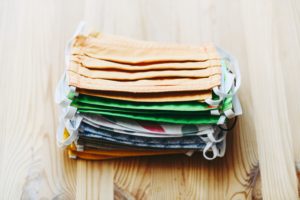Lessons in Sustainability: What We Learned from the Pandemic
 We’re all in this together, or so the saying goes. And in many ways, it’s been proven true: The pandemic affected all of us in a variety of different ways. Some of us had to learn to work from home while others lost their jobs. Still others among lost loved ones or suffered our own long-term effects as a result of the virus.
We’re all in this together, or so the saying goes. And in many ways, it’s been proven true: The pandemic affected all of us in a variety of different ways. Some of us had to learn to work from home while others lost their jobs. Still others among lost loved ones or suffered our own long-term effects as a result of the virus.
In response, we’ve done what we do — and what nature does — best: We’ve adapted. We found new jobs or set up home offices. We grieved our losses and changed our behavior to ensure that we didn’t lose others. We learned that, in this context, “survival” and “sustainability” are really two words for the same thing.
The pandemic has offered us plenty of lessons about sustainability and confirmed what many of us have long known about our ecosystem and how we affect it. Adaptation is just one of those lessons. Here are a few others.
We’re all connected.
Sustainability is about ecosystems and interdependence. If we didn’t know already, the pandemic reminded us how connected we all are within this vast ecosystem of Planet Earth.
The rapidity with which COVID-19 spread across the globe showed us how vulnerable we are to a highly contagious virus. It spread like wildfire — and that’s more than just an analogy, as wildfire has wreaked havoc on the Amazon ecosystem, destroying vast reaches of habitat for one in every 10 species on Earth.
Because we’re all interconnected, we’re all vulnerable. That’s a lesson from the pandemic we should certainly take forward. And we should take steps to reduce that vulnerability whenever and wherever possible by putting protections and preventive measures in place — not just for humanity, but also for our planet.
It’s possible to reduce emissions.
People have been talking for years about reducing emissions from automobiles, but it took a pandemic to show us how much we could accomplish.
Global CO2 emissions dropped by 6.4% in 2020 compared to the previous year, and the decline was more than double in the United States, at 12.9%. Some manufacturers closed during the pandemic, while lockdowns and travel restrictions kept large numbers of cars and other vehicles off the road.
Remote work kept commuters at home, which reduced the pollution belched into the atmosphere by idling motors on jammed freeways during rush-hour traffic. And many employees want to keep things that way:
A Morning Consult survey in March 2021 found that 87% of workers want to work at least one day a week remotely going forward, and a full 42% of current remote workers said they’d look for another job if their employer forced them to return to the office.
We can reduce emissions in other ways, too, such as more sustainable commuting, carpooling, riding our bikes when possible. When it comes to preparing for and responding to disaster, choosing reusable supplies and environmentally-sensitive tools is a must. Employing a washable face mask to protect you from future viruses and installing a CARB-compliant generator for backup power when the lights go out may seem like small steps, but they can make a big difference. The more creative we can get about reducing greenhouse gases, the more sustainable we’ll make our world.
Invisible threats can be deadly.
When we talked about waging war on COVID, it was a poorly chosen metaphor because, in war, usually you can see the enemy. Opposing forces may hide or camouflage themselves, but you know they’re there, and they can be exposed.
The novel coronavirus was different. You couldn’t see it, so you didn’t know who had it. As a result, we took steps to protect ourselves against the possibility of spreading or contracting it, from wearing masks and social distancing to using hand sanitizers and disinfectant wipes.
Our failure to protect ourselves as effectively as we might have led to more than 600,000 deaths in the United States. And while 56% of Americans surveyed in December said we failed to take the virus seriously enough, nearly 1 in 5 (18%) said we either overreacted to it, or it was a hoax.
Similar reactions to other invisible threats — such as toxic emissions and climate change — have put us in similar peril. Our tendency to ignore threats we can’t see and avoid those that don’t affect us directly, such as ocean garbage and e-waste, has caused severe and deadly damage.
COVID can be a wake-up call for us not to ignore invisible threats. They’re just as real as (and sometimes more dangerous than) the ones we can see.
Science is important.
To understand our environment and create a more sustainable world, we need to know how things work. Science helps us do that.
Science isn’t always right, but as nature adapts to new circumstances, science adapts to the new information it gains. The ability to learn from our mistakes is key, and science helps us do that by advancing us toward a better understanding of the world.
Scientific advances, from wearing the proper personal protective equipment to developing vaccines, were essential to combating the virus and making our lives sustainable despite the threat. Similar advances will help us create a more sustainable world in the face of other threats we’re already facing and those we’re sure to face in the future.
By Jessica Larson, SolopreneurJournal.com


Sorry, the comment form is closed at this time.